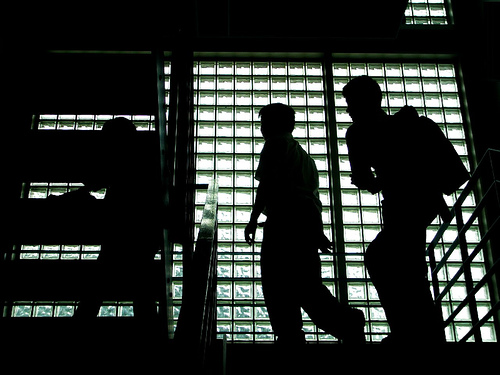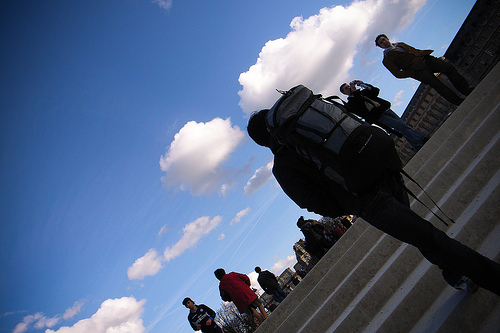Everyone learns the virtue of packing light the hard way. My most recent lesson came during a two-day jaunt to Chicago, where — in anticipation of “getting a lot of work done” — I brought my laptop and several books. That, along with an extra jacket, dress clothes, a change of shoes, my bike and two heavy locks. All of which (except the bike) I packed into a decidedly non-ergonomic messenger backpack.
Vagabondish is reader-supported. When you buy through links on our site, we may earn a small affiliate commission. Read our disclosure.
Needless to say, the 10-mile ride north from the Loop to where I was staying that night was very long indeed. Worse, however, was riding around the following day with aching shoulders, sweating and then shivering in the bitter wind. Among all the bulky, needless stuff I’d lugged with me, I had neglected to bring a pair of long underwear.
This little episode also taught me the importance of packing smart. Throughout my brief traveling career, I’ve mainly towed my belongings in cumbersome duffels and spine-twisting messenger bags. I often envied the travelers I encountered at campgrounds and hostels who comfortably bore their possessions in slick hiking packs, but a general lack of knowledge about the benefits of such bags (not to mention their usually hefty pricetags) has kept me from investing in one myself.
As I prepare to launch back out into the world — living and traveling overseas for an indefinite period of time — I’ve reevaluated, and began searching for that perfect bag. As I might’ve expected, there’s a lot of brands, features, materials, zippers and pockets out there. But the question one should always start with in choosing a bag appears to be quite simple: what do you need it for?

Backpackers Silhouette, Tokyo © tanakawho
Choosing a Size
Most backpacks will tell you their size right in the name. For example, the Arc’Teryx Naos 55 is going to provide you with 55 liters of space, the Gregory Baltoro 70 is going to provide you with 70 liters, and so on. How this space is distributed may vary with style (lots of pockets? no pockets?) but the numbers make comparison across brands pretty easy.
Many novice backpackers, such as myself, may think it’s better to play it safe by going big. After all, you can always just leave extra room, right? The thing about that idea, an employee at a local sporting goods store told me, is that travelers tend to fill what space they have in their packs no matter what — meaning that you might unwittingly end up lugging a ton of needless stuff on your next trip to, say, Chicago.
Having a smaller bag will force you to carry less — which is not always a bad thing.
Before buying a pack, think long and hard about what you’re going to use it for. Are you mostly going to be hostel-hopping in European cities, or are you planning to rough it for weeks on end in the Australian outback? Sixty to 70 liter bags are going to be plenty for most travelers, but those who are taking on more extreme journeys should be looking at higher numbers. When it comes down to it, having a smaller bag will force you to carry less — which is not always a bad thing.
Style and Brand
As in most things, when buying a backpack, you get what you pay for. Spend $100 bucks on a 60 liter pack and it may hold up fine for the first couple years, but don’t expect any long-term life out of it. For something quality, I’m told, one should expect to drop upwards of $200. Generally bags within a similar price range are going to be comparable whether it’s made by REI, Osprey, Gregory or any other company.
What does differ across brands, however, is where the money goes into the bag. For example, one $250 bag may have a lot of different compartments and a rain cover included, but the back ventilation may not be so hi-tech. Another $250 bag may be the opposite. Don’t be lured by a bag simply because of brand recognition; that North Face pack you’re looking at might be great, but it’s not the perfect bag for you just because it says “The North Face”.
As for all those zippers and pockets: organization-prone travelers might lean towards excess in this area, but there are advantages to simplicity. Bags like the Deuter Futura 50 or the North Face Primero 70, which are essentially just big tubes, are nice in the sense that it’s going to be difficult for someone to slip a hand into your bag without you noticing. The sacrifice here is that you might have to root around to get what you’re looking for; packing smart can minimize this.

Backpacking, Paris © *Solar ikon*
The Proper Fit
Since you’re going to be lugging some heavy poundage around in this thing, getting the correct fit is of the utmost importance. As I’m not an expert, I won’t go into great detail about this, but I will share some of what I learned from the experienced backpackers I talked with.
The biggest advantage to a quality internal frame bag is that it distributes most of the weight to your hips, which can comfortably bear a significantly heavier load than your shoulders ever could. Thus, it’s critical to have a hip belt that fits well. The cloth padding from the belt should come around and extend just past your iliac crest, before the strap and buckle start. If the strap is digging into your hips, this is no good. Some bag makers, like Osprey, have hip belts that can be custom molded — a worthwhile investment if you plan on trekking a long ways.
In addition to the liter size of the bag, most packs also come in small, medium and large torso sizes. Ideally, if you have the proper fit, the shoulder straps will connect with the bag just below your shoulders — otherwise you’ll bear the load awkwardly and uncomfortably.
For more information, consult with an employee at a reputable sporting goods store (I’d stay away from mass retailers like Dick’s or Big 5).
Packing and Taking Off
When it comes to packing your new bag, try to keep the majority of the weight towards the small of your back. For 50 to 60 liter bags, this generally means putting the heavy stuff in the bottom. For larger packs, however, start off with something light — t shirts or a pair of shoes — before dropping in heavier equipment. Also remember to try and keep things balanced. Even if you don’t feel it after the first mile, packing a full water bottle on one side with nothing to even it out on the other is going to put you under some strain.
Ideally, you should set your full bag on a bed or park bench before squatting down to lift it up. Obviously this isn’t always possible, but try to slide it on to both shoulders as quickly and smoothly as possible to avoid injury. When you’ve got 60 pounds loaded up, you can’t be flinging this thing on like it’s a kid’s bookbag.
Finally, look out for your bag’s safety before getting on the plane. I’ve heard horror stories of TSA officials simply cutting off loose straps from checked backpacks, so make sure everything you have is cinched down and tucked in before letting your pack go down that conveyor belt. Otherwise, some manufacturers do sell travel sacks to wrap your bag in, but I’ve heard that a plastic garbage bag works just as well. Just remember to cut a hole where the shoulder straps can stick out; you don’t want the baggage handlers yanking your pack around by a cord that isn’t supposed to be load-bearing.
Above all, if you’re going to drop several hundred dollars on a sweet bag, use it — hard. A backpack is a beautiful, freedom-granting thing. Though I bought my bag (an Osprey Aether, by the way) initially to help me move overseas, I know that it’s constantly going to be tempting me to load up and fly out the door — and hopefully helping me take only what I need.


